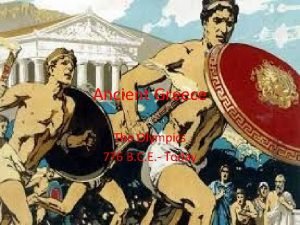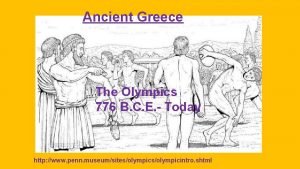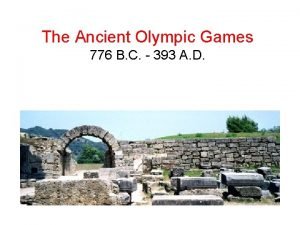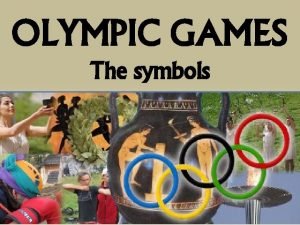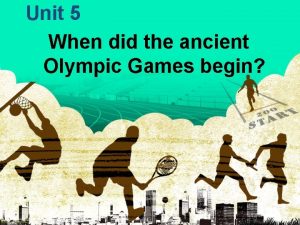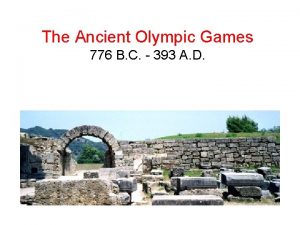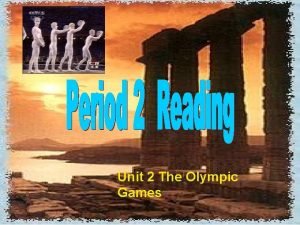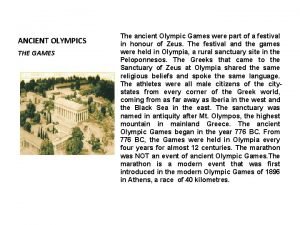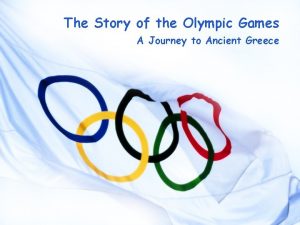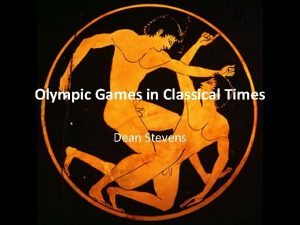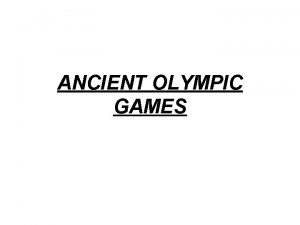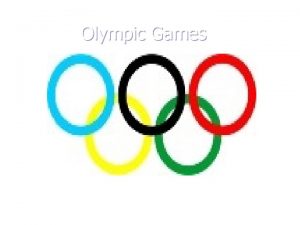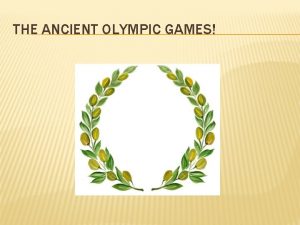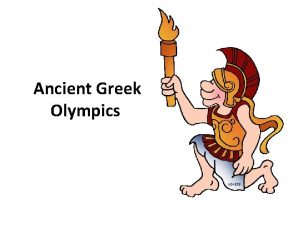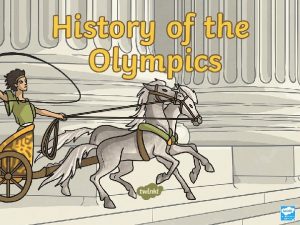ANCIENT OLYMPICS THE GAMES The ancient Olympic Games











- Slides: 11

ANCIENT OLYMPICS THE GAMES The ancient Olympic Games were part of a festival in honour of Zeus. The festival and the games were held in Olympia, a rural sanctuary site in the Peloponnesos. The Greeks that came to the Sanctuary of Zeus at Olympia shared the same religious beliefs and spoke the same language. The athletes were all male citizens of the citystates from every corner of the Greek world, coming from as far away as Iberia in the west and the Black Sea in the east. The sanctuary was named in antiquity after Mt. Olympos, the highest mountain in mainland Greece. The ancient Olympic Games began in the year 776 BC. From 776 BC, the Games were held in Olympia every four years for almost 12 centuries. The marathon was NOT an event of ancient Olympic Games. The marathon is a modern event that was first introduced in the modern Olympic Games of 1896 in Athens, a race of 40 kilometres.

ANCIENT OLYMPIC EVENTS • The ancient Olympics were rather different from the modern Games. There were fewer events, and only free men who spoke Greek could compete, instead of athletes from any country. Also, the games were always held at Olympia instead of moving around to different sites every time.

BOXING Ancient boxing had fewer rules than the modern sport. Boxers fought without rounds until one man was knocked out, or admitted he had been beaten. Unlike the modern sport, there was no rule against hitting an opponent when he was down. There were no weight classes within the mens' and boys' divisions; opponents for a match were chosen randomly.

EQUESTRIAN EVENTS: CHARIOT RACING • There were both 2 horse chariot and 4 horse chariot races, with separate races for chariots drawn by foals. Another race was between carts drawn by a team of 2 mules. The course was 12 laps around the stadium track (9 miles).

RIDING • The course was 6 laps around the track (4. 5 miles), and there were separate races for fullgrown horses and foals. Jockeys rode without stirrups. • Only wealthy people could afford to pay for the training, equipment, and feed of both the driver (or jockey) and the horses. As a result, the owner received the olive wreath of victory instead of the driver or jockey.

PENTATHLON • This was a 5 -event combination of discus, javelin, jumping, running and wrestling.

PENTATHLON: DISCUS • The ancient Greeks considered the rhythm and precision of an athlete throwing the discus as important as his strength. • The discus was made of stone, iron, bronze, or lead, and was shaped like a flying saucer. Sizes varied, since the boys' division was not expected to throw the same weight as the men.

PENTATHLON: JAVELIN • The javelin was a manhigh length of wood, with either a sharpened end or an attached metal point. It had a thong for a hurler's fingers attached to its center of gravity, which increased the precision and distance of a javelin's flight.

PENTATHLON: JUMP • Athletes used lead or stone jump weights (halteres) shaped like telephone receivers to increase the length of their jump. The halteres were held in front of the athlete during his ascent, and forcibly thrust behind his back and dropped during his descent to help propel his body further.

PENTATHLON: RUNNING • There were 4 types of races at Olympia. The stadion was the oldest event of the Games. Runners sprinted for 1 stade (192 m. ), or the length of the stadium. The other races were a 2 stade race (384 m. ), and a long-distance run which ranged from 7 to 24 stades (1, 344 m. to 4, 608 m. ).

PENTATHLON: WRESTLING • Like the modern sport, an athlete needed to throw his opponent on the ground, landing on a hip, shoulder, or back for a fair fall. 3 throws were necessary to win a match. Biting was not allowed, and genital holds were also illegal. Attacks such as breaking your opponent's fingers were permitted.
 776 b.c.e
776 b.c.e Olympics greece
Olympics greece Ancient olympics vs modern olympics
Ancient olympics vs modern olympics The ancient olympic games were initially:
The ancient olympic games were initially: Citius altius fortius logo
Citius altius fortius logo Ancient olympics ppt
Ancient olympics ppt The ancient olympic games were initially
The ancient olympic games were initially Unit 2 games
Unit 2 games Javelin ancient olympic games
Javelin ancient olympic games Opening ceremony ancient greek olympics
Opening ceremony ancient greek olympics Ancient olympic games
Ancient olympic games Ancient greek olympics primary sources
Ancient greek olympics primary sources
